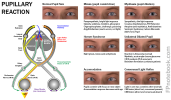II. Pathophysiology
- Paralysis of superior cervical Sympathetic Nerve
- Lesions interrupt sympathetic fibers
- Courses to the Carotid Artery (in petrous Temporal Bone) and then to the orbit
- First order Neuron injury
- Ipsilateral fibers from Hypothalamus, through pons and Medulla to the spinal cord C8-T2
- Second order Neuron injury (preganglionic sympathetic)
- Preganglionic sympathetic fibers from T1 to superior cervical Ganglion (C3-4)
- Third order Neuron injury (postganglionic sympathetic)
- Sweat Gland denervation (Anhidrosis) via fibers along the external Carotid Artery
- Long ciliary nerve denervation (Miosis) via fibers along the Internal Carotid Artery
- Follow Internal Carotid Artery to carotid plexus
- Through Cavernous Sinus (alongside CN 6)
- Follow CN 5 (ophthalmic branch) to eye
- Associated lesions
- Images
III. Causes
- Vascular
- Neurologic Conditions
- Demyelinating Disease (e.g. Multiple Sclerosis)
- Infection (Encephalitis, Meningitis)
- Posterior retroparotid space mass
- Parotid Gland tumor
- Carotid body tumor
- Metastatic tumor
- Lymphoma
- Tuberculous Adenitis
- Mediastinal Mass
- Apical Lung Lesion (e.g. Pancoast Tumor)
IV. Signs
- Mnemonic: Miosis, Ptosis, Anhidrosis
- All findings are unilateral
- Miosis
- Palpebral Ptosis (Incomplete)
- Absence of sweating (Anhidrosis) on face and neck

